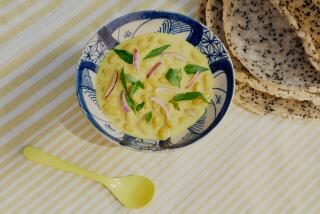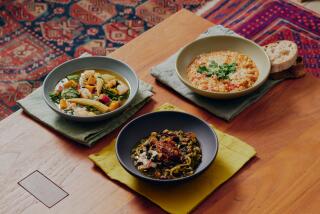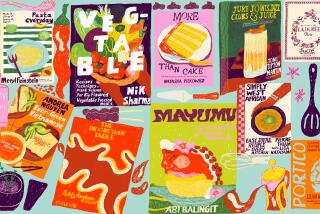A Stew That’s ‘Simply Spring’
- Share via
A couple of years ago, I decided to make a spring vegetable stew from Joel Robuchon and Patricia Wells’ “Simply French” (Morrow, 1991). Since I was serving a simple main dish, roast salmon, I had been looking for a side with some complexity. And because it was early spring, I wanted the dish to show off the first fresh vegetables of the year.
The picture of the stew in the cookbook was pretty and the list of ingredients included all the right things: baby carrots, fresh peas, fava beans, baby turnips, chanterelles and baby bulb onions.
It required a special trip to the farmers market (and all the priciest vendors, of course) to come up with the baby vegetables required. And then I started cooking.
I soon realized that although each vegetable was stewed in only a tablespoon or two of butter, there were eight or nine vegetables, and that added up to more than a stick of butter for six people. What’s more, each vegetable took at least 10 to 15 minutes to cook, which meant about an hour and a half of steady stirring.
The result was pretty delicious, as almost anything containing a cup of butter would be, though it didn’t really show off the vegetables so much as the process. And given the amount of time and expense involved--not to mention (which I rarely do) the calories--I never made the stew again.
But spring seems like a time for vegetable stews, and the other day, after picking up some nice salmon fillets for dinner, I got nostalgic for that Robuchon spring stew, though certainly not for the work and weight that went into it.
Even though it’s warmer and we’re eating less meat, there’s something reassuringly homey about the heft of stew and the almost spontaneous way in which it is put together. And there’s something about all of those tender little green things in the produce bins this time of year that makes me want to cook them.
I picked through the produce department, gathering some little boiling potatoes here and a bargain-priced package of artichokes there. The sugar snap peas were crisp and, when I tasted one, still sweet; I added those. There were no bulbing onions, so I substituted regular green onions, using only the white parts to keep the flavor mild. I got a couple of fresh shiitake mushrooms (I’ve really come to love the way even a little adds a subtle meaty smokiness to vegetable dishes). Finally, remembering the cool herbal flavor of the lettuce I braise with English peas, I picked up a pale green heart of romaine.
Rather than cooking endless rounds of vegetables in butter, I blanched them all in boiling water: sugar snaps first, just long enough to set the color, then the potatoes and finally the artichokes, to avoid confusing the flavors. At the last minute, I turned them all in just enough butter flavored with the onions and mushrooms and a healthy handful of chopped fresh herbs from my garden.
It’s actually an extremely simple dish accepting of wide variation. If you like the looks of asparagus this week, use that instead of the artichokes (for some reason I can’t really pin down, combining those two doesn’t work for me). Some carrots would be great, and if you’re at a farmers market, some shelly beans would be even greater.
The main thing is to be sure not to overcook the potatoes. I did that the first time I made this, and they started to break down in the second cooking. It didn’t affect the flavor, but the little bits of spud muddied up the look of the dish and made the texture a little heavy.
Though not nearly as heavy as a full stick of butter.
SPRING VEGETABLE STEW
1 pound sugar snap peas
Salt
1 1/2 pounds small white boiling potatoes cut into walnut-size pieces
4 artichokes, trimmed to heart
2 tablespoons butter
2 fresh shiitake mushrooms, stems discarded, coarsely chopped
1 bunch green onions, white parts only, cut in 1-inch lengths
1 head romaine lettuce, interior white leaves only, coarsely chopped
1 teaspoon chopped fresh mint
2 tablespoons chopped fresh oregano or marjoram
1/4 cup chopped fresh parsley
Juice of 1/2 lemon
Cook sugar snap peas in large pot of rapidly boiling, lightly salted water, just until bright green but still crisp, 30 to 45 seconds. Remove to mixing bowl full of ice water to set color.
Cook potatoes in same boiling water until barely tender, about 15 minutes. When done, remove from pan, salt lightly and drain on kitchen towel.
Add artichoke hearts to boiling water and cook until just tender, about 15 minutes. Drain, remove fuzzy chokes with serrated grapefruit spoon and cut in eighths lengthwise. (Dish can be prepared to this point up to 4 hours in advance and refrigerated until almost ready to serve.)
Melt butter in large skillet or Dutch oven over medium-low heat. Add mushrooms and green onions and cook until onions soften, 15 to 20 minutes.
Add potatoes and artichokes and cook just until heated through. Add sugar snap peas and lettuce and cook just until lettuce wilts, about 5 minutes. Add mint, oregano and parsley and stir to mix well. Add lemon juice. Season to taste with salt. Do not cook for too long or potato will begin to break down.
6 servings. Each serving:
208 calories; 232 mg sodium; 10 mg cholesterol; 4 grams fat; 38 grams carbohydrates; 8 grams protein; 3.79 grams fiber.
(BEGIN TEXT OF INFOBOX / INFOGRAPHIC)
Kitchen Tips
*If your potatoes are walnut-sized and need no further trimming, be sure to cut a “belly band” around the middle, removing a thin strip of peel to keep the potatoes from bursting when they cook.
*To clean artichokes quickly, remove the outer leaves by turning the base of the artichoke against a very sharp knife just until the yellow heart is visible. Cut off the top 1/3 of the artichoke and peel the stems and base. Remember that artichoke stems are full of flavor too and only need to be peeled.
More to Read
Eat your way across L.A.
Get our weekly Tasting Notes newsletter for reviews, news and more.
You may occasionally receive promotional content from the Los Angeles Times.










